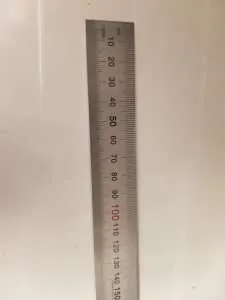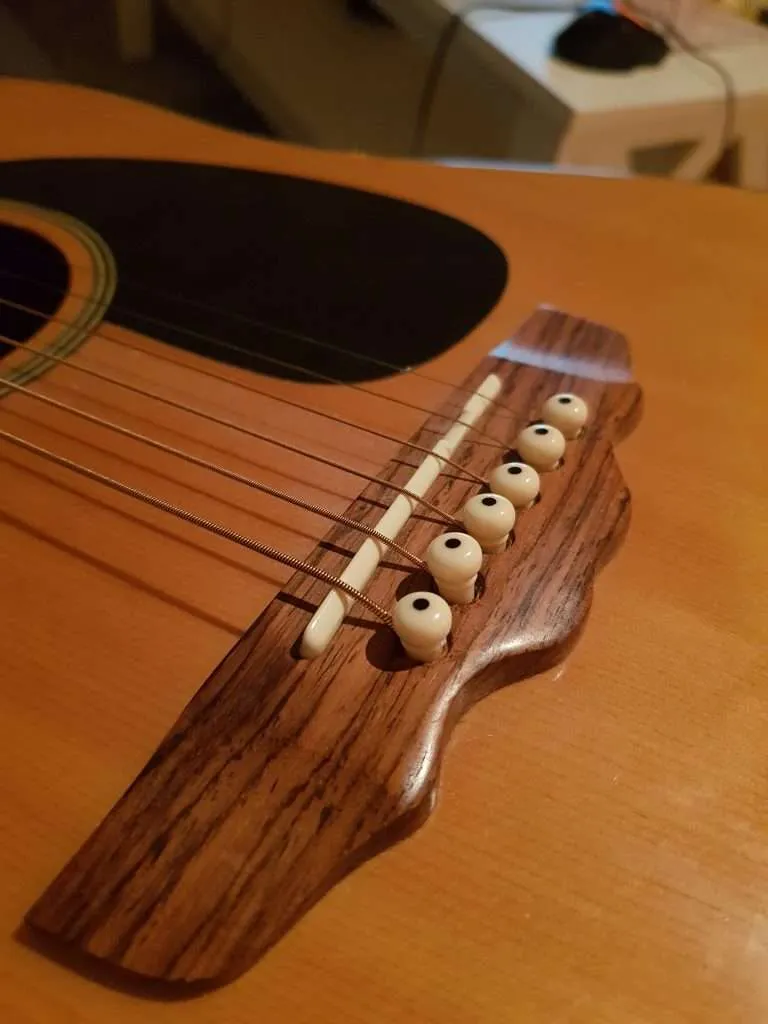Guitar Action – A Complete Guide

If you have no clue how to do this, don’t worry, we’ve got you covered. You will learn all you need to know in the guide below.
Mục Lục
What Is Guitar Action
Guitar action is nothing more than the height of the guitar strings over the fretboard. It’s something that plays a huge role in how your guitar feels to play. It will also affect the sound.
High action gives the strings plenty of room to vibrate, and the guitar sounds great. Too high and it will be uncomfortable to play. Low action offers great playability, but if it’s too low then you’ll start to get fret buzz.
A good setup will increase comfort, eliminate buzzing, improve sustain and also improve intonation
Why electric guitars have lower action
The way we play an acoustic is very different from how we play an electric. We control sound with how forcefully we play, and so the strings need more room to vibrate. And of course, fret buzzing is much more audible in an acoustic. To get those clear, ringing notes the action can’t be too low.
For an electric guitar on the other hand, you can play with a lighter touch and still create massive sounding notes. It’s also less vulnerable to fret buzz due the effects of amplification and pedals. Even with a slight buzz when unplugged, you won’t hear it when you plug it in. So getting a lower action is no problem.
What Should The Action Be On Your Guitar?
The obvious answer is of course what feels comfortable, but there are a few things to consider. Most guitarists prefer the action to be as low as their playing styles allow without fret buzz.

Playing style and guitar action
So are you the smooth shredder, or that delicate jazz player with a fondness for fast runs? Or are you the typical singer songwriter, strumming away with sweeping gestures? Or maybe you’re that metal guitarist who loves banging out power chords on stage?
Of course, the lighter your touch, the lower your action can be. As long as you stay clear of that dreaded rattling of strings against the fretboard…
What should the action be on an electric guitar
I’m not sure there is a standard string height for an electric guitar, but typically the action is set to 1.6 mm on the high E and 2.4 mm on the low E. This is a good starting point. See how it feels, and if you want to go lower just go for it. Lower it slightly and listen for any increase in buzzing. If no notable increase can be heard feel free to lower it some more.
What should the action be on an acoustic guitar
The typical string height for acoustic is, as expected, a little higher and measures at around 2 mm on the high E, and about 2.8 mm on the low E.
Going lower, even if possible, may not always be what you want. If you use a capo a lot you’ll find that the capo lowers the action of the guitar, making it actually play and sound better with a slightly higher action.
If you’re into slide guitar you might even consider going higher. It sounds really bad when playing with a slide and the strings fret out. You want that smooth glide between notes, and a nice high action helps.
When is the action too high?
It’s very easy to tell when the action is too low, but can you tell when it’s too high? Yup, you sure can. High action can mess with your intonation. If the distance you need to push the string to reach the fret is too great, then it can cause the string to bend out of tune.

You can easily check this by playing the natural harmonic at the 12th fret, and then compare the fretted note at the same fret. If there is a difference between the two, then your intonation is off.
Before Making Any Adjustments
Before you start adjusting the action on your guitar, there are a few things you might want to check. It’s always a good thing to first find out exactly how high the action is. For this you’ll need the at least one of the following tools:


If you use a ruler it has to start the measurements from the very end, as it allows you to get an accurate reading when you press it against the frets. We’re dealing with very small measurements here, so your tools need to be accurate.
Measuring the action

Start by tuning your guitar to ensure the neck has the right tension. Then start measuring the distance from the top of the 12th fret to the low E string. Do the same for the high E string. If the bridge allows you to adjust each saddle’s height, then you’ll need to measure the action on each string.
Correct neck relief
Check the neck and make sure it isn’t bowed. A neck with an upbow or back-bow needs a truss rod adjustment. You can read more about that here.
Intonation
If your guitar isn’t intonated properly, it will not play in tune as you move up the fretboard. As already mentioned, you can check this easily. First play a natural harmonic at the 12th fret, and then compare it with the fretted version at the 12th fret. Are they the same? If not, the saddle at the bridge might allow for adjustments sideways to change the length of the string. If you don’t feel like experimenting with intonation I would recommend taking it to a guitar tech.
Level frets
Frets need to be level and have a nicely formed crown. If they are uneven in height they can cause buzzing. This could be due to poor build or simply because they are worn down.
Adjust Action on an Electric Guitar
As already mentioned, checking the neck and making truss rod adjustments will affect string height. This is however not always necessary, so provided the neck is nice and straight you should continue with the steps below.
Adjusting the bridge or saddle height
Adjusting the action on electric guitars differs from one guitar to another, depending on what type of bridge it has. Some bridges allow for each individual string to be adjusted. Others only allow you to adjust the entire bridge
Tune-o-Matic Bridges

Mostly found on Gibson and Epiphone guitars, these types of bridges are fairly easy to adjust. As seen in the picture, it only allows for adjusting the screws in the posts, either lowering or raising the entire bridge, or only the bass side or treble side. With this type of bridge you only have to measure the low and high E string. Make small adjustments at a time, measure again, tune up and try it out.
The one drawback here is of course if the action on the middle strings is too high or low, since you’ll need to adjust the entire bridge to compensate.
Floyd Rose Bridges
 “Floyd Rose close up” by jonsson is licensed under CC BY 2.0
“Floyd Rose close up” by jonsson is licensed under CC BY 2.0
Just like the Tun-o-Matic bridges, these bridges use two posts to adjust the height. Your approach to adjusting is the same, but you might have to use to use an Allen wrench instead of a flathead in some cases.
Fender-style Bridges
 File:2008 Fender USA Stratocaster (lefthand) – Synchronized tremolo bridge.jpg by Duncan Brown (Cradlehall) is licensed under CC BY 2.0
File:2008 Fender USA Stratocaster (lefthand) – Synchronized tremolo bridge.jpg by Duncan Brown (Cradlehall) is licensed under CC BY 2.0
The big difference here is that these bridges allow for each individual string to be adjusted. Use a small Allen wrench (usually 1.5 mm) to adjust both screws on each saddle. Make sure the two screws are equally adjusted. You need to go through each string, first measure and then adjust. Even though these bridges allow for more control over string height, the actual process of adjusting is a lot slower and requires more patience.
Adjusting nut height?
Normally the nut can be left as is. It’s rarely affected by the same factors that cause changes in action over time. However, nuts do eventually wear down a little. So if truss rod and bridge adjustments don’t do the trick, you might want to consider replacing the nut altogether.
How to Adjust Action on an Acoustic Guitar
Changing the action on electric guitars is fairly straightforward, and doesn’t require a whole lot of craftsmanship. You can pretty much fiddle about with it as much as you like, until you get it to where you want it to be. If you go too far in one direction this is easily reversible.
This cannot be said when it comes to acoustic guitars. Quite contrary, if you find that you need to adjust the bridge saddle on your acoustic you’re in for a slow and painful process. And you need to be very careful.

To lower the action by adjusting the bridge you first need to loosen the strings enough so that you can remove the saddle. Then you have to start filing it down. Be careful though, if you file off too much you’ll have to buy a new saddle and start again. It’s therefore a good idea to do a little at a time, and put the saddle back in between and tune up so that you can measure the action again.
As this is a delicate and time consuming process, it may very well be easier to have a guitar tech do it for you.
What Changes Action Height
If you have a well setup guitar that plays like a dream every time you pick it up, it’s easy to think it will stay like that forever. Not always the case I’m afraid.
All of a sudden you notice that your action seems to be a bit off, and you’re not sure why. Don’t worry, there might be a perfectly good reason for it.
Temperature and humidity changes
It’s no secret that temperature and humidity affect the wood in a guitar. Big swings in temperature might cause the wood to warp a bit. Moisture causes the wood to swell, dryness causes it to shrink. So, be mindful of how and where you store your guitar.

String gauges and tension
It’s also well known that changing the gauge of your strings may alter the tension across the neck, thus affecting the string height. This is of course not always the case, but it’s a good thing to be aware of. If the action has changed after a switching to a new set of strings, always check the neck first before adjusting the bridge. A simple turn of the truss rod might just do the trick.
What to do next
As far as electric guitars go, action is something you can definitely experiment with. It’s one of those things where you tweak a little here and there to find your sweetspot, without worrying too much about the consequences.
Even though the same can’t be said for acoustics, you can still do truss rod adjustments, and even change the nut to achieve the desired effect.
Don’t be afraid to have a go at this. Most guitars you buy won’t be set up the way you like, so you might as well learn this right away. Go with the guitar action that works for you. No one else can make that decision for you.
Speaking of guitar setup, don’t forget to check out our guide on How to adjust the neck on your guitar.















![Toni Kroos là ai? [ sự thật về tiểu sử đầy đủ Toni Kroos ]](https://evbn.org/wp-content/uploads/New-Project-6635-1671934592.jpg)


